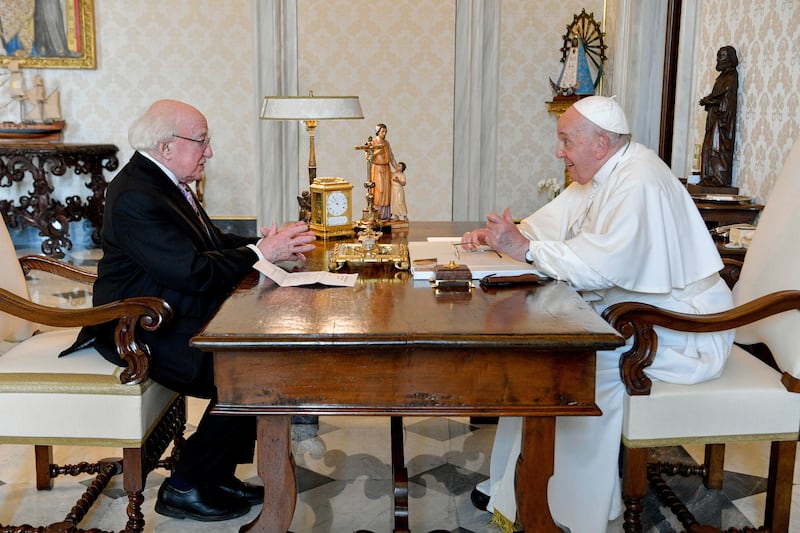Pope Francis faces a difficult task in moving the Catholic Church towards being more inclusive of women and LGBT people, President Michael D Higgins has said after meeting the pontiff.
The private audience in the Pope’s library in the Vatican on Thursday was one of a series of engagements by the President on a trip to Italy this week.
“He faces grave difficulties in the institution of which is head. I get a sense of that nearly every time I meet him. But his heart is in the right place,” President Higgins told reporters.
“He’s reaching out to people in the LGBT community” and “those who feel that they haven’t been labelled as Catholics”, Mr Higgins continued.
The nine biggest TV shows of 2025 so far: Why you should watch them, and where you can catch them
‘I was seven in 1975 when I committed myself to Leeds United, then I watched a great team fall apart’
Look inside: Light-filled redbrick with ‘iceberg’ extension in Portobello for €1.4m
How can investors manage in the world according to Trump?

“His heart is open, and he refers to that very often.”
The meeting came as the Vatican holds a synod assembly about the future of the church that is being closely watched for signals of reform. This month, Pope Francis issued guidance on blessing same-sex unions that was interpreted as opening the door to the practice.
Earlier this week, Pope Francis met New Ways Ministry, a United States organisation that advocates for LGBT Catholics and which was previously denounced by the Vatican for causing confusion on the church’s position towards homosexuality.
Co-founder, Sr Jeannine Gramick, issued a statement to say the meeting was “very emotional” for her. It was the fifth time the two have met, and President Higgins said he felt that the pontiff faced a difficult battle within the church to move it towards reform but that there may be an opportunity for change.
“Though the synod and the outcome of the synod, there should be a consideration of the role of believers, men and women in relation to a Church that is changing,” he said.
“Look at the people he has allowed back into the discussion,” he continued.
“There are people who have been excluded from the discourse that should have been long, long back, and there are people who’ve been deeply wounded by this.”
Pope Francis was well aware of Mr Higgins’s views that the church should be more liberal, the president said. “We discussed the role of women,” Mr Higgins told reporters. “We discussed his recent announcement, welcoming the capacity, or the space that would be given to the blessing of civil unions and the position of the LGBT community.”
LGBT representatives had asked Mr Higgins to pass on their appreciation of his guidance on blessings, the president said, though he added that there was a long way to go.
“Women should be participating fully as equals at every level, every policy decision in relation to the church and in its administration,” Mr Higgins continued. “That’s a tough journey for him.”
“I don’t give instructions to the Pope. But the pope knows where I stand,” he told reporters. “And he has no difficulty with it.”
The two also discussed common interests on climate change, global poverty, and migration, as well as issues affecting central and South America with the two exchanging some words in the Argentinian pontiff’s native Spanish.
Mr Higgins presented Pope Francis with a sculpture by Irish artist John Behan called The Expelled, in recognition of the pontiff’s work on drawing attention to the plight of refugees and migrants.
Following the private audience, Mr Higgins laid a wreath in the nearby Teutonic Cemetery to honour Monsignor Hugh O’Flaherty, an Irish priest who saved the lives of thousands during the Nazi occupation of Rome by operating out of the Vatican and moving people into safe houses. This year marks 60 years since his death.














